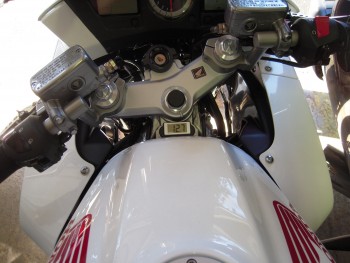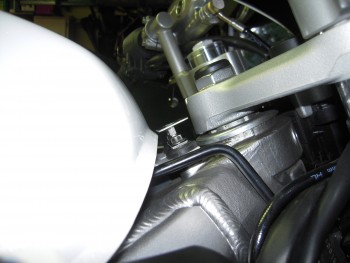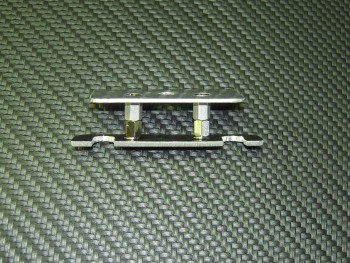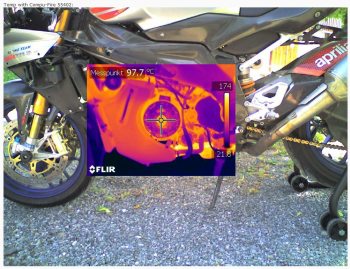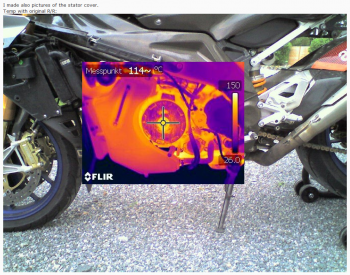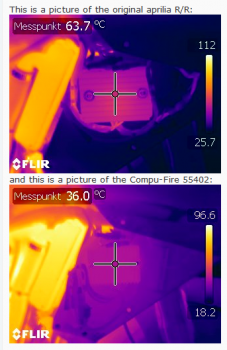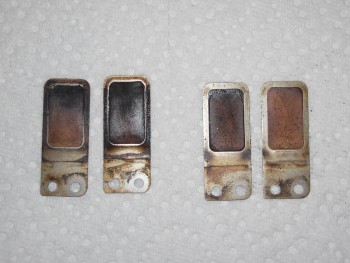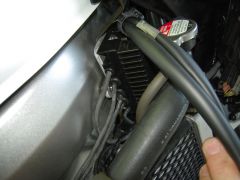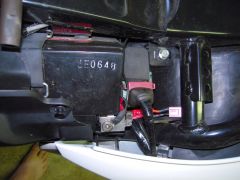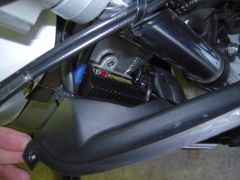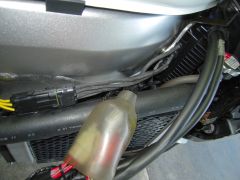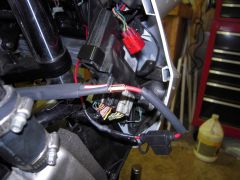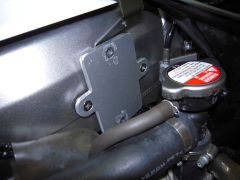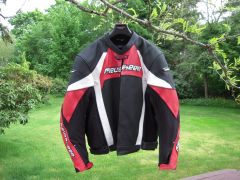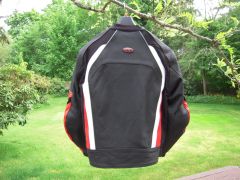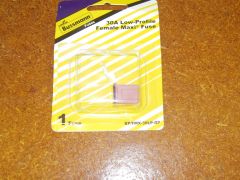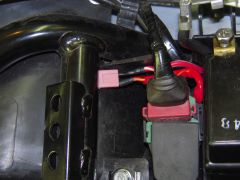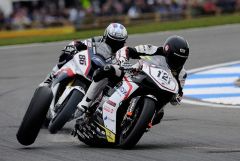-
Posts
543 -
Joined
-
Last visited
-
Days Won
2
Content Type
Forums
Profiles
Gallery
Blogs
Downloads
Events
Everything posted by coderighter
-
I thought you were OEM R/R? Mine has failed three times at around 40,000 miles the factory stator(replaced with Ricks) failed at about 51,000 miles the factory R\R opened replaced with Electrosport series R\R. At 64,000 the stator failed again, replaced with the Honda stator and Shin R\R. I did a quick search and Electrosport doesn't appear to make a series design R/R. All I could find on their website were shunt style. If you search the word 'series' on their site several R/R's show up, but the word 'series' is denoting a group, not a regulator design. Kind of like a BMW 5 series, a group of cars based off the same platform. If you used a true series type R/R, under normal use, the actual power produced by the stator would be cut by 25-35% ( more with HID's and LED's ) which should reduce stator heat by the about same amount. That would make sense I have HID's but not for long .. Thanks Coderighter ..... Just wondering, why are you removing the HID's?
-
I thought you were OEM R/R? Mine has failed three times at around 40,000 miles the factory stator(replaced with Ricks) failed at about 51,000 miles the factory R\R opened replaced with Electrosport series R\R. At 64,000 the stator failed again, replaced with the Honda stator and Shin R\R. I did a quick search and Electrosport doesn't appear to make a series design R/R. All I could find on their website were shunt style. If you search the word 'series' on their site several R/R's show up, but the word 'series' is denoting a group, not a regulator design. Kind of like a BMW 5 series, a group of cars based off the same platform. If you used a true series type R/R, under normal use, the actual power produced by the stator would be cut by 25-35% ( more with HID's and LED's ) which should reduce stator heat by the about same amount.
-
I thought you were OEM R/R?
-
Let's look at the thermo's again. Keep in mind the each image is scaled independently, with white being the hottest and black being the coldest you can't compare images color to color. The plus target in the middle is the is the target temp. I'll doing the conversion from Celsius to Fahrenheit. The first image is scaled 78-302 and the targeted is temp 237. This is with the shunt R/R The second image is scaled 71-345 with the target temp being 206. This is with the series R/R. The difference is 21 degrees but it's actually a bigger difference than that because the highest temp on the second image is higher, meaning the engine temp as a whole was likely higher.
-
HELLO HELLO anybody home .... #13
-
They say it's 'Splash proof'. Mine came with a rubber gasket for the back, so I don't think that will be a problem. I only ride for fun, so I avoid the rain, but I guess if needed, I could clear coat the whole thing. It's very easy to see during the day, but there's no back light for night. However, around town, street lights are enough to see it. I have a female RCA jacket in place of one of the inner push clips that I have hooked to the battery which I use for charger or aux. I was in a hurry to take a ride, so for now I have the meter plugged into the RCA. In future I'll put it on the battery directly.
-
Actually, I was more proud of the mount but here's the meter. http://www.jameco.com/webapp/wcs/stores/servlet/ProductDisplay?langId=-1&storeId=10001&catalogId=10001&pa=2095040&productId=2095040&CID=octopart I just really wanted a LCD to match the bike's gauges
-
I just thought I'd share my voltmeter install, as I don't think I've seen another like it. The bottom bracket is slotted so that I can slide it out of the way once the bolts are loose, making the bolts easier to remove.
-
A lot of people look at this the wrong way. The stator, the R/R, and the wires/connectors between them are all one system. If you replace the R/R with something more efficient, you'll overload the stator. If you replace the stator with one with larger winding, you will more than likely increase the output potential, overloading the R/R. If you replace both with upgrades, your just making more heat. In theory, the series R/R fixes all of that.
-
99.9% of the time, good advice, but probably not in the bazaaro world of the shunt regulator. The purpose of the heavier gauge, short wire, is to help prevent voltage drop. Unless your running a bunch of heated gear and need all 480 watts, that 'saved' voltage will just be shunted to ground anyway. 'Less' of a voltage drop would just be more heat in the stator and R/R. All you really need is wire of a big enough gauge to not over heat. That being said, the wire in question is so short, the difference between 14 and 12 gauge won't make a hill of beans either way. Best bet is to use the wire size spec'd for the connector. If you want a really happy stator and R/R, run 10 feet of 20 gauge aluminum wire jacketed in asbestos.
-
Actually CandyRedRC46 had a problem with his Compufire where everything was fine until he got to 9000 RPM, at which point the voltage would go up to 16-17 volts. He called Compufire and they told him that it was designed and built for thier stators in Harleys. http://www.vfrdiscussion.com/forum/index.php/topic/66106-just-installed-a-compufire-series-regulator/page-6 The red line for the FS800 is 8500 RPM. When you search the web, the bike owners that are having real good luck with Compufires, are owners that have bike with red lines less 10k, mostly 2 cylinders.
-
I've actually measured the current and with the stock shunt R/R, mine was 12.3 amps per leg. This my vary slightly bike to bike so I would peg max at 12.5 amps. 14 gauge wire is rated for 15 amps max.
-
Switching is not a problem, we're talking solid state. I think Tightwad was right in that the Compufire couldn't handle the high RPM since it was developed for Harleys. Stator voltage increases with engine RPM and a common spec voltage for capacitors is 63 volts. 63 volts is right at the VFR's top end output.
-
Maybe for the R/R, not for the stator. The VFR has 480 watt system. With a permanent magnet altenator and shunt regulator, the regulator shunts (or shorts) the stator to ground until the stator is loaded to the point that the voltage falls to the target voltage. The fact that you're adding load with the lights means the regulators job is a little easier, but the load on the stator is the same, 480 watts. Doesn't matter what you connect to the system, the stator sees 480 watts. The difference is how much current the regulator has to shunt to ground to make up the balance of the 480 watts and hold the voltage down. Example, if you had 300 watts of lights, the regulator would have to pass to ground (consume) 180 watts to 'hold' voltage down to target voltage. If you had 400 watts of lights, the regulators job got easier as it now only has to 'consume' 80 watts. In theory, a series regulator switches the current path on and off really fast in such a way that the current allowed to pass, is enough to maintain the target voltage. Keep in mind, that if the stator is not connected to a load, it generates nothing. Using this method, the stator would only be asked to produce the amount power needed by the load. Using the same example, the 300 watts of lights, would only load the stator to 300 watts instead of the 480 watts with the shunt regulator. If you take it one step further and replace your lights with HID's and leds, you could drop your stator load to 200 watts. Just imagine how happy your stator would be. A shunt regulator is akin to having a cruise control that pins the throttle open and maintains the speed by applying the brakes as needed to hold the speed down. A series regulator is akin to a cruise control that pulses the throttle until the target speed is met. +1 and the real killer is the heat that the stator produces inside of hot running engine. Agreed.... and here's some interesting photos on the subject.
-
Maybe for the R/R, not for the stator. The VFR has 480 watt system. With a permanent magnet altenator and shunt regulator, the regulator shunts (or shorts) the stator to ground until the stator is loaded to the point that the voltage falls to the target voltage. The fact that you're adding load with the lights means the regulators job is a little easier, but the load on the stator is the same, 480 watts. Doesn't matter what you connect to the system, the stator sees 480 watts. The difference is how much current the regulator has to shunt to ground to make up the balance of the 480 watts and hold the voltage down. Example, if you had 300 watts of lights, the regulator would have to pass to ground (consume) 180 watts to 'hold' voltage down to target voltage. If you had 400 watts of lights, the regulators job got easier as it now only has to 'consume' 80 watts. In theory, a series regulator switches the current path on and off really fast in such a way that the current allowed to pass, is enough to maintain the target voltage. Keep in mind, that if the stator is not connected to a load, it generates nothing. Using this method, the stator would only be asked to produce the amount power needed by the load. Using the same example, the 300 watts of lights, would only load the stator to 300 watts instead of the 480 watts with the shunt regulator. If you take it one step further and replace your lights with HID's and leds, you could drop your stator load to 200 watts. Just imagine how happy your stator would be. A shunt regulator is akin to having a cruise control that pins the throttle open and maintains the speed by applying the brakes as needed to hold the speed down. A series regulator is akin to a cruise control that pulses the throttle until the target speed is met.
-
It's always seems kind of weird to me to install a really efficient R/R. It would seem that the more efficient the R/R, the more load the stator is exposed to, and the shorter the stators life. Sure the R/R is bolt proof, but at the cost of the stator? Maybe? It seems like there's been quite a few members that upgrade their R/R's and then develop a bad stator. One has to wonder why. It's the whole chicken and egg thing. I know the technology is new, but I believe a series R/R is the answer. I recently read where Polaris is now using them, so I believe the day is coming.
-

Any interest in sharing oil testing data?
coderighter replied to KevCarver's topic in Maintenance Questions
He's a whole bunch to collect info from. http://www.bobistheoilguy.com/forums/ubbthreads.php?ubb=postlist&Board=49&page=1 -
Ya, I tried the tensioner. I even tried replacing the auto with a fixed type. When I sold it, i think I had 23k or so on it. Maybe just unlucky. I do, however, miss that massive mid range torque the ZRX has on tap.



